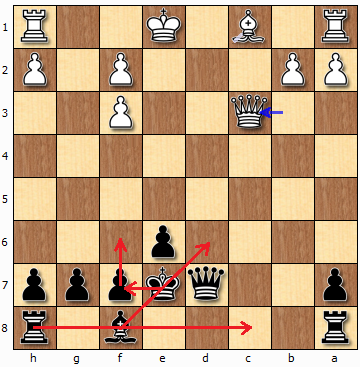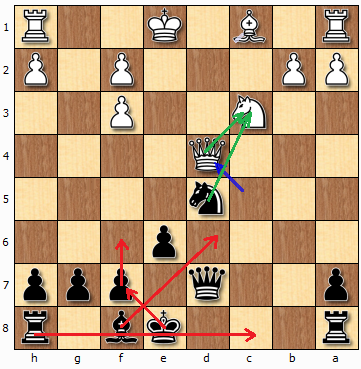09:37 Panov – Botvinnik Variation, Epilogue |
According to Panov analysis, the main line of the considered variation is the following: 1. e4 c6 Thus, we get the position:
×
8
7
6
5
4
3
2
1
                                                                a
b
c
d
e
f
g
h
Usually the game continues: 14. N x d5+ Q x d5 15. Q x d5 ed and Black gets the equal endgame. But what to do for Black if White avoids the queen exchange? This is the subject of this article. => If White queen leaves the b5 square for any square where it defenses the c3 knight then the sides exhcnage the knights. Firstly Black takes the c3 knight moving N x c3. Then White takes the Black’s knight moving Q x c3 because the bc move is less preferred as White gets the two weak pawns (the c3 and a2 pawns) in this case. For example, the game may continue: 14. Q b3 N x c3 Now the Black’s king is open and the Black king side’s pieces are not developed. How to sole this problem? The natural answer to this question is - let's rearrange the pieces according to the red arrows in the picture below.
Thus, the f pawn clears the way for the king moving to the f6 square. The king hides behinds the pawns in the f7 square. Then the bishop is developed to the d6 square and the h rock goes to the c8 square. Does our plan work? Let us look: 15. … f6
And Black haven’t experienced any hindrances to implement its plan and got all the problems solved. What if the White’s queen goes to the square where it does not defense the c3 knight in the fourteenth move? If so Black takes the c3 knight again and implements the similar plan. The difference of these two cases is that White takes a knight back moving bc. In result, White gets two weak pawns – the c and a pawns. In this case, the Black’s bishop may be developed to other square comparing with the original plan and the Black’s rock may stay in the h8 square if it is better for the position of this variation. Thus, the game may continue: 14. Q e2 N x c3 15. bc f6 16. 0-0 Kf7 17. R d1 Q c6 18. c4 Be7 19. B e3 h5 20. f4 f5 21. Q f1 Q f3 22. Q g2 Q x g2+ 23. K x g2 R hc8 24. R d7 R x c4 25. R b1 K f8 26. R bb7 B f6 27. R f7+ K g8 28. R x a7 R x a7 29. R x a7 B d4 30. B x d4 R x d4. => Again, Black solves all its problems and gets the equal endgame. Finally, what if the queen goes to the c4 square making a check to the Black's king in the fourteenth move? Surprisingly, but the same plan works in this case too: 14. Q c5+ K e8 15. Q d4 … =>
Now, again, Black takes the c3 knight moving N x c3 and White takes a knight back moving Q x c3. After this, Black implements the same plan (see the red arrows in the picture above). The only difference is that the Black’s king starts from the other square comparing with the original plan. Thus, the game may continue: 15... Nxc3 Itis mistake for White to move 15. Q a5?? Because the game continues: 15. Q a5 B b4 16. Q a6 N x c3 17. bc B x c3+ 18. K e2 B x a1 19. B a3 R b8 20. R x a1 Q b5+ 21. Q x b5+ R x b5 22. R c1 K d7 and White loses the material. => After 15. Q b5 Black gets a nicer position because the game continues: 15. Q b5 B b4 16. Q x d7+ K x d7 17. B d2 B x c3 18. bc R hc8 19. R g1 g6 20. R b1 R ab8 21. R x b8 R x b8 22. R g4 R b1+ 23. K e2 R b2 24. R d4 K c7 25. R c4+ K b7 26. a4 Ra2 27. Kd3 N b6 28. R f4 f5 29. R h4 h5 30. R d4 e5 31. R d8 K c7 32. R g8? e4+ 33. fe fe+ 34. K e2 N c4 => It’s not good idea for White to move 16. Q d3 because the game continues: 16. Q d3 N x c3 17. Q x d7+ K x d7 18. a3 B a5 19. B d2 R hc8 20. R g1 g6 21. bc B x c3 22. R c1 B a5 23. K e2 B x d2 24. K x d2 and Black should win in this variation. => Still worse, 16. Q c4? Because the game continues: 16. Q c4 R c8 17. Q b3 R x c3 18. bc B x c3+ 19. B d2 B x a1 20. Q b8+ Q d8 21. Q x a7 B e5 22. R g1 g6 23. R g4 Q c7 24. Q a4+ K e7 25. K f1 R c8 and Black wins the material. =>
|
|
|
| Всего комментариев: 0 | |




